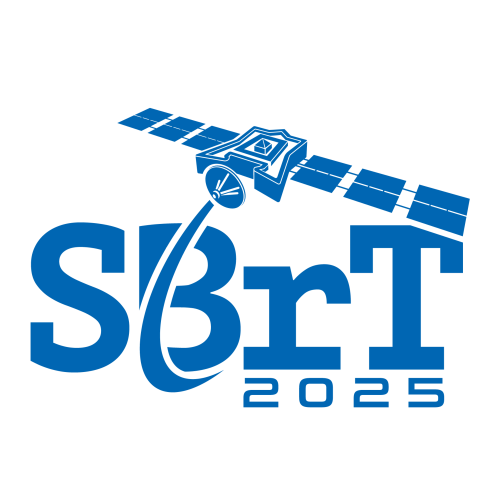
XLIII Simpósio Brasileiro de Telecomunicações e Processamento de Sinais

Um Esquema de Marca d'água Robusto em Imagens Baseado em Aprendizagem Profunda
Andy Martin, Cecilio Pimentel, Daniel Chaves
DOI: 10.14209/sbrt.2025.1571144212
Keywords:
Abstract
Neste trabalho, propomos um esquema de marca d'água em imagens baseado em aprendizado profundo, no qual as camadas de inserção e extração são treinadas de forma iterativa para garantir alta robustez contra ataques. A camada de inserção adota uma estrutura paralela com redes neurais convolucionais inspiradas na rede Inception, enquanto a camada de extração emprega convoluções deformáveis. Estas permitem a extração adaptativa de características da imagem ao ajustar os filtros convolucionais de acordo com o conteúdo da imagem. Os bits inseridos na imagem correspondem aos bits de paridade de um código corretor de erros, contribuindo para a integridade da informação. O desempenho do sistema é avaliado sob diversos ataques comuns na literatura e os resultados demonstram que a abordagem proposta é eficaz e competitiva em relação a métodos recentes.Download
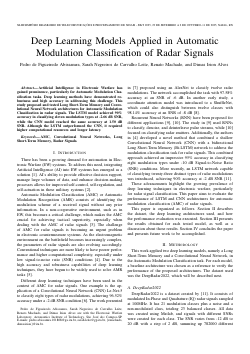
Deep Learning Models Applied in Automatic Modulation Classification of Radar Signals
Pedro De Figueiredo Abissamra, Sarah Leite, Renato Machado, Dimas Irion Alves
DOI: 10.14209/sbrt.2025.1571144222
Keywords: AMC Convolutional Neural Networks Long Short-Term Memory Radar Signals
Abstract
Artificial Intelligence in Electronic Warfare has gained prominence, particularly for Automatic Modulation Clas- sification tasks. Deep learning methods have demonstrated ro- bustness and high accuracy in addressing this challenge. This study proposed and tested Long Short-Term Memory and Convo- lutional Neural Network architectures for Automatic Modulation Classification in radar signals. The LSTM model achieved 90% accuracy in classifying eleven modulation types at -2.66 dB SNR, while the CNN model reached the same accuracy at 1.50 dB SNR. Although the LSTM outperformed the CNN, it required higher computational resources and longer latency.Download

Enhanced Ballistic Trajectory Estimation from Radar Data Using the Cubature Kalman Filter
Daniel Miñan de Oliveira Crus, João Abdalla Ney da Silva, José Antonio Apolinário Jr.
DOI: 10.14209/sbrt.2025.1571144226
Keywords: Cubature Kalman Filter Ballistic Trajectory Trajectory Estimation Weapon Locating Radar Ballistic Coefficient
Abstract
This paper investigates the use of the Cubature Kalman Filter (CKF) for estimating the trajectory of a projectile with known ballistic parameters using simulated radar measurements from a Weapon Locating Radar. The CKF is a nonlinear filtering technique with enhanced accuracy and numerical stability compared to the Extended Kalman Filter and the Unscented Kalman Filter. We evaluate the Cubature Kalman Filter performance under realistic measurement noise and dynamic conditions. The simulation results demonstrate improved tracking accuracy and robustness, highlighting its potential as a reliable solution for ballistic trajectory estimation in defense applications.Download
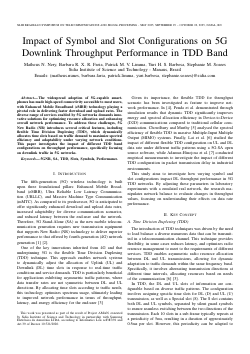
Impact of Symbol and Slot Configurations on 5G Downlink Throughput Performance in TDD Band
Matheus Nunes Nery, Bárbara Regina Xavier Ribeiro Faria, Patrick Medeiros Limma, Yuri Hernan Santos Barbosa, Stephanie M Soares
DOI: 10.14209/sbrt.2025.1571144230
Keywords: 5GNR SA TDD Performance
Abstract
The widespread adoption of 5G capable smartphones has made high-speed connectivity accessible to most users, with Enhanced Mobile Broadband (eMBB) technology playing a pivotal role in delivering faster download and upload rates. The diverse range of services enabled by 5G networks demands innovative solutions for optimizing resource allocation and enhancing overall network performance. To address these challenges, 5G New Radio (NR) introduces several critical features, including flexible Time Division Duplexing (TDD), which dynamically allocates time slots based on traffic demand to maximize spectral efficiency and adaptability under varying network conditions. This paper investigates the impact of different TDD band configurations on throughput performance, specifically focusing on downlink traffic in 5G networks.Download
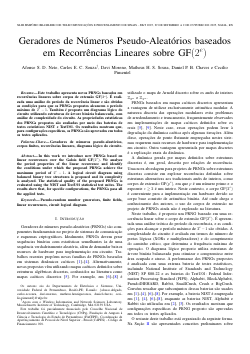
Geradores de Números Pseudo-Aleatórios baseados em Recorrências Lineares sobre GF(2^e)
Afonso de Sá Delgado Neto, Carlos Eduardo Correia de Souza, Davi C. M. de Almeida, Matheus H da Silva Sousa, Daniel Chaves, Cecilio Pimentel
DOI: 10.14209/sbrt.2025.1571144252
Keywords:
Abstract
In this work we introduce new PRNGs based on linear recurrences over the Galois field GF(2^e). We analyze the period properties of the linear recurrence and identify the conditions under which the proposed PRNGs achieve the maximum period of 2^e − 1. A logical circuit diagram using balanced binary tree structures is proposed and its complexity is analyzed. The statistical quality of the proposed PRNGs is evaluated using the NIST and TestU01 statistical test suites. The results show that, for specific configurations, the PRNGs pass all the applied tests.Download
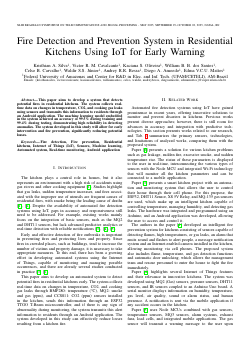
Fire Detection and Prevention System in Residential Kitchens Using IoT for Early Warning
Kristhian Silva, Victor Cavalcante, Kaciana Oliveira, William Santos, Edma Urtiga de Mattos, Diego A. Amoedo, Andrey Ruben Ribeiro Bessa, Waldir Silva, Celso Carvalho
DOI: 10.14209/sbrt.2025.1571144284
Keywords:
Abstract
This paper aims to develop a system that detects potential fires in residential kitchens. The system collects real-time data on changes in temperature, CO2, and cooking gas leaks using sensors and transmits this information to residents through an Android application. The machine learning model embedded in the system achieved an accuracy of 99.5\% during training and 99.4\% during testing, demonstrating high reliability in detecting anomalies. The system developed in this study will allow for early intervention and fire prevention, significantly reducing potential losses.Download

A Machine Learning and UFW-based Security Architecture for Mitigating DoS Attacks on MQTT Networks
Matheus Figueiredo, Luca Naja, Nelson Silva, Eneida Soares, Diego A. Amoedo, Andrey Ruben Ribeiro Bessa, Edma Urtiga de Mattos, Waldir Silva, Celso Carvalho
DOI: 10.14209/sbrt.2025.1571144294
Keywords:
Abstract
The expansion of the Internet of Things (IoT) presents significant security challenges due to the limited resources of many IoT devices and their insufficient protection mechanisms. Lightweight protocDownload

Análise da Pontualidade da Informação em Redes Long-Range Frequency Hopping Spread Spectrum
João Mateus de Almeida Ambrósio, Jamil Farhat, João Luiz Rebelatto, Glauber Brante
DOI: 10.14209/sbrt.2025.1571144319
Keywords: LR-FHSS Pontualidade da Informação Internet das Coisas
Abstract
Neste trabalho, investigamos o desempenho da técnica Long-Range Frequency Hopping Spread Spectrum (LR-FHSS), com foco na relação de trade-off entre goodput e Pontualidade da Informação (em inglês Age of Information, AoI). Especificamente, avaliamos o desempenho de diferentes taxas de dados (em inglês Data Rates, DR) padronizadas do LR-FHSS, analisando como essas métricas se relacionam entre configurações de DR diversas. Nossos resultados numéricos demonstram que uma análise baseada apenas no goodput é insuficiente em cenários onde a atualização da informação é crítica. Além disso, mostramos que configurações de transmissão não padronizadas podem apresentar melhor desempenho, dependendo dos parâmetros e configurações da rede.Download
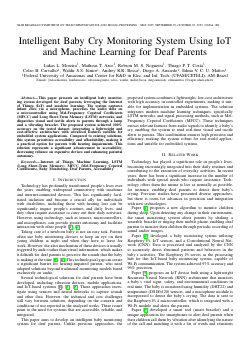
Intelligent Baby Cry Monitoring System Using IoT and Machine Learning for Deaf Parents
Lukas Moreira, Matheus Arce, Robson Nogueira, Thiago Costa, Edma Urtiga de Mattos, Diego A. Amoedo, Andrey Ruben Ribeiro Bessa, Waldir Silva, Celso Carvalho
DOI: 10.14209/sbrt.2025.1571144325
Keywords:
Abstract
This paper presents the development of an intelligent baby monitoring system for deaf parents, utilizing IoT (Internet of Things) and machine learning. The system captures the baby's cries through a microphone, processes the data in a microcontroller using MFCC (Mel-Frequency Cepstral Coefficients) and LSTM (Long Short-Term Memory) networks, and sends visual and tactile alerts to parents via a lamp and a vibrating bracelet. The proposed system achieves 100% accuracy in the tested dataset, combining a lightweight and cost-effective architecture with advanced features for embedded systems applications. Compared to existing solutions, it emphasizes accessibility and affordability, making it a practical choice for parents with hearing impairments. This solution represents a significant advancement in accessibility, reducing the reliance on expensive devices and providing greater autonomy for parents.Download

Machine Learning Models for Virtual Base Station Power Consumption Estimation
Elen C. R. Gomes, Lucas Rodrigues, Diego de Freitas Bezerra, Djamel Hadj Sadok, Glauco Estácio Gonçalves
DOI: 10.14209/sbrt.2025.1571144356
Keywords: Energy efficient 5G vRAN Power Modelling
Abstract
The growing demand for energy efficiency in mobile networks has driven the adoption of virtualized Base Stations running on general-purpose processors. This paper compares machine learning models for estimating power consumption using data from four processor architectures. Extreme Gradient Boosted Trees Regressions delivered the most accurate and robust predictions. Neural Networks exhibited unstable performance, particularly on specific platforms, whereas Linear Regressions demonstrated lower reliability in low-power scenarios. Results highlight the critical importance of aligning the processor architecture with the chosen model to ensure practical power estimation and energy optimization.Download